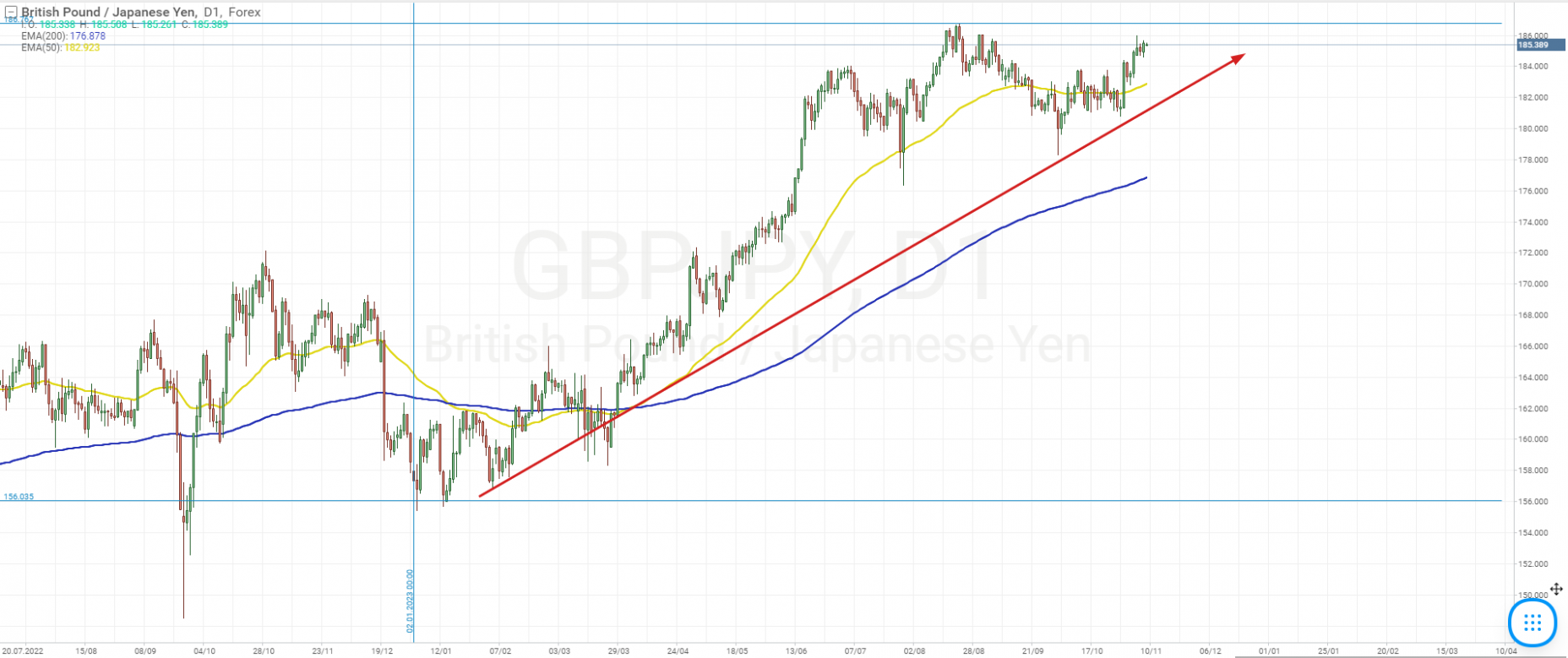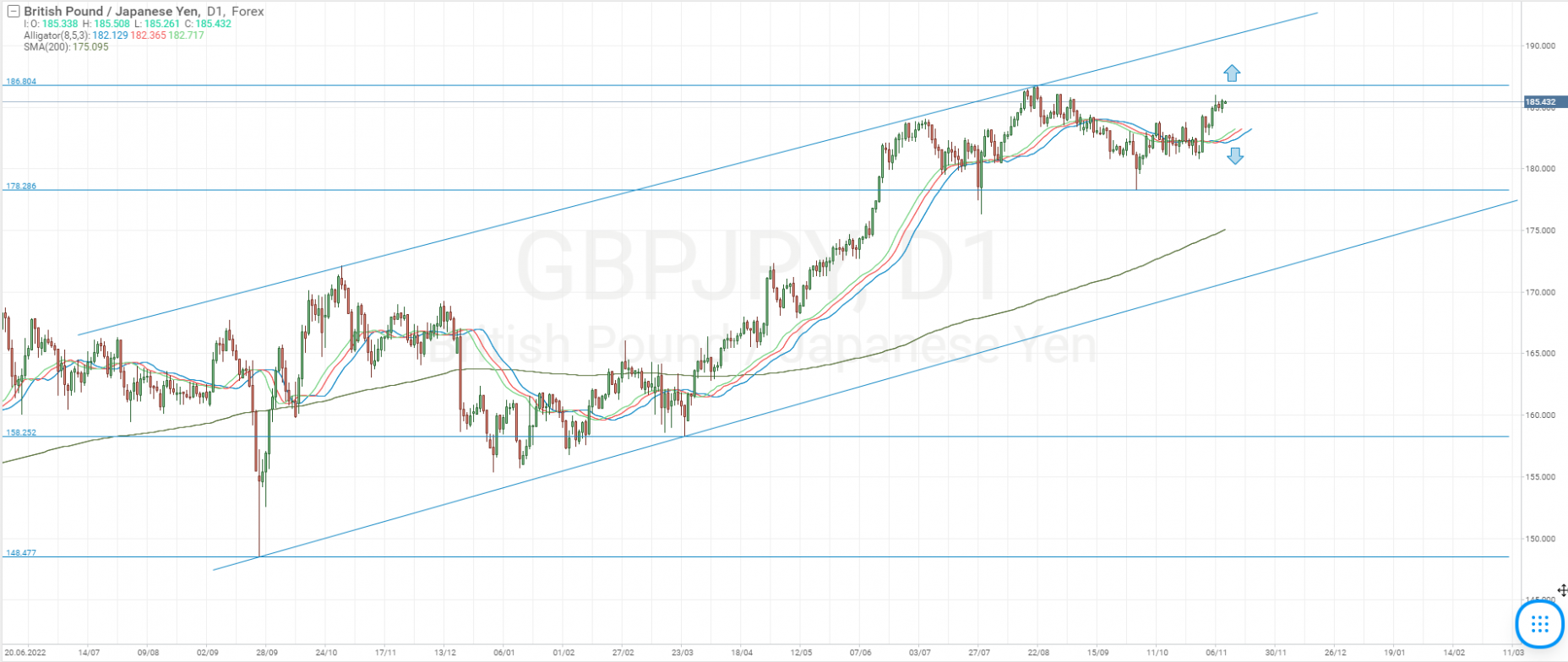GBP/JPY Forecast: Will the Correction Begin in 2024?

8 minutes for reading
The GBP/JPY pair is among the currency pairs that are highly favoured in the global currency market. In this article, we will examine the primary fundamental factors affecting the GBP/JPY exchange rate, analyse its performance in 2023, and explore the short-term and medium-term forecasts provided by experts for 2024.
You can visit the RoboForex Market Analysis webpage for the latest forex forecasts.
Overview of the GBP/JPY currency pair
The GBP/JPY pair is a cross rate comprising the two popular currency pairs, GBP/USD and USD/JPY. It is worth reminding that a cross rate is the value of one country’s currency denominated in another country’s currency and determined based on their value against a third country’s currency. In this case, the latter refers to the US dollar, the key international reserve currency. The GBP/JPY exchange rate reflects fluctuations in the British pound sterling (GBP) value against the Japanese yen (JPY).
The UK currency is the base currency in this pair, and the current price reflects how many yen are needed to buy or sell one pound sterling. When the pair quotes increase, it indicates a strengthening UK currency. Conversely, a decline signifies a weakening pound sterling against the yen.
Trading characteristics of the GBP/JPY pair
- The yen exerts the most significant influence on the currency pair’s performance. If there is a strong directed movement of the JPY, the pair’s quotes are likely to follow it. At the same time, owing to its high volatility, the GBP may occasionally set the direction of the movement
- The pair trades round the clock from Monday to Friday inclusive
- The highest activity is observed during the Asian, European, and American trading sessions
- The GBP/JPY pair experiences high daily volatility within the 1,000-1,500 pips range. During times of market force majeure, it has the potential for strong movements exceeding 3,000 pips per day
- Thanks to its popularity and high liquidity, the spread for this pair ranges around 10 pips in a quiet market
Fundamental factors influencing the GBP/JPY quotes
The Bank of England’s monetary policy
The primary tool used by the Bank of England, the UK’s central bank, to control inflation and influence the exchange rate of the national currency is the implementation of changes in the interest rate. If the interest rate increases, the pound sterling exchange rate appreciates, while a decrease in the interest rate leads to a decline in the exchange rate. Since December 2021, the Bank of England has executed a series of interest rate hikes to curb mounting inflation.
The rate increased from 0.1% to 5.25% during this period. The Bank of England’s Monetary Policy Committee aims to achieve a 2% inflation target. In October 2023, the Consumer Price Index (CPI) rose by 6.7% compared to 2022 figures. With inflation rates slowing, the UK central bank paused its interest rate hikes from August 2023. The regulator sees risks of a potential slowdown in the country's economy due to a significant tightening of credit terms.
Therefore, further actions on interest rates will depend on economic data. If the UK’s GDP declines and recession signs emerge, this may negatively impact the pound exchange rate, with the GBP/JPY pair coming under pressure. Conversely, strong GDP growth and high inflation might prompt the regulator to raise the interest rate again, bolstering the pound against the yen.
The Bank of Japan’s monetary policy
The Japanese economy has been in a state of deflation for over two decades. It means a decrease in the general price level of goods and services - a phenomenon opposite to inflation, negatively affecting the economy’s growth rate. Therefore, the Bank of Japan and the country’s government made numerous efforts to eliminate deflation. They have used a zero-interest rate and implemented a quantitative easing (QE) policy to inject additional monetary funds into the economy.
The yen’s low interest rate has made it an attractive option for investments and lending. Japan has experienced over a year of rising core inflation, with the ratio exceeding the central bank’s target level of 2%. Despite this, the Bank of Japan's governor, Kazuo Ueda, remains cautious about hastening monetary policy tightening.
First, Japan has recently overcome long-standing deflation; second, the export-oriented country benefits from a weak national currency as its goods become more affordable than products from other countries. However, if the yen depreciates too rapidly, the Bank of Japan might resort to foreign exchange interventions by buying the yen against the pound, which may exert short-term pressure on the GBP/JPY exchange rate.
Economic development indicators of the UK and Japan
- Monetary policies of the Bank of England and the Bank of Japan: changes in interest rates, QE and QT programmes, and foreign exchange interventions
- Unemployment Rate
- GDP Growth Rates (GDP)
- Inflation Indices (CPI, PPI)
- Industrial Production Index
- Retail Sales
- Trade Balance
- A business activity report by the Bank of Japan (Tankan survey)
GBP/JPY performance in 2023
The GBP/JPY pair has maintained a consistent upward trend throughout 2023. The quotes surged from a low of 156.00, where they hovered at the beginning of the year, to a 7-year high of 186.76 in late August. The absence of clear signals from the Bank of Japan regarding potential monetary tightening exerts upward pressure on the yen, driving the currency pair’s quotes higher.
At the same time, the Bank of England has actively raised interest rates throughout 2023 in response to mounting inflationary pressure. The significant difference between the rates resulted in the serious weakening of the yen and the gradual growth of the pair’s exchange rate. At the time of writing on 9 November 2023, the quotes hovered around 185.40, nearing their annual high.

GBP/JPY live chart
GBP/JPY technical analysis
The pair has steadily grown since September 2022, moving within the long-term daily ascending channel. At the end of August 2023, the quotes reached an annual high of 186.76, followed by a slight downward correction during which the price hit a low of 174.28. It is worth noting that this is now a local support level.
The Alligator indicator and the 200-day SMA show a consistent uptrend. Currently, the likeliest scenario is that the quotes will continue to rise to renew the high of 186.76 with possible upward movement to 190.00. However, if the quotes cannot consolidate above 186.76 and drop lower after that, this will signal a possible beginning of a downward correction. Its target could be the support level of the daily price channel and the 200-day SMA at 175.00.

GBP/JPY forecasts and predictions for 2024
- Economy Forecast Agency (EFA) analysts forecast that the pound-to-yen exchange rate will rise and stand at 203.04 by the end of 2024, 222.14 by the end of 2025, and 244.40 by the end of 2026
- According to the Wallet Investor portal, the pair will continue its rally, reaching 199.46 by the end of 2024 and 212.36 by the end of 2025
Summary
The GBP/JPY currency pair has been showing a steady upward movement in 2023 and continues it in early 2024, hitting its highest value since 2015. The big difference in the interest rates between Japan and the UK supports this growth.
The trend persists, and the pair’s quotes could rise further. A downward correction could start if the UK shows signs of emerging recession, or the Bank of Japan decides to raise the interest rate.
Traders and investors should also bear in mind that if the yen continues to depreciate rapidly, Japan’s central bank may use foreign exchange interventions to restrain a fall in the national currency. This could trigger explosive volatility growth and short-term sharp declines in the pair’s quotes.
FAQ
Why is GBP/JPY forecasting important?
Forecasting is essential for strategic planning and risk management, helping investors predict possible movements of the currency pair.
What methods are used to forecast GBP/JPY?
Commonly employed methods include fundamental analysis, technical analysis, and sentiment analysis.
How accurate are GBP/JPY forecasts?
While forecasting methods have their advantages, they are not entirely reliable. Various factors can affect GBP/JPY and trigger unexpected price movements.
What are the risks in GBP/JPY forecasting?
The primary risk lies in the unpredictability of global political and economic events that can significantly affect the GBP/JPY rate.
What potential future events could trigger GBP/JPY exchange rate changes?
The list of potential events is extensive, including shifts in the monetary policies of the UK and Japanese regulators, possible foreign exchange interventions of the Bank of Japan, geopolitical changes, natural and human-caused disasters, and crisis developments in national and global economies.
Will the GBP/JPY exchange rate continue to remain volatile?
Influenced by various factors, the GBP/JPY rate may maintain its volatility.
How does the difference in interest rates affect the GBP/JPY rate?
An interest rate hike in the UK drives up the pair’s quotes, whereas a potential increase in the interest rate in Japan will contribute to the GBP/JPY downward movement.











